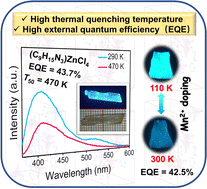J. Mater. Chem. C, 2022,10, 13137-13142.https://doi.org/10.1039/D2TC02838G

Low-dimensional organic–inorganic metal halides with broad light emission have drawn widespread attention, however, the low thermal stability has been a major obstacle to their commercialization. Herein, zero-dimensional (C9H15N3)ZnCl4 with space group P21 was synthesized for the first time. (C9H15N3)ZnCl4 emits blue fluorescence at room temperature with external quantum efficiency as high as 42.5%, which are among the highest reported for Zn-based OIMHs, and it is comparable with the commercialized phosphors. Notably, the luminous integral intensity of (C9H15N3)ZnCl4 at 470 K remains more than 50% of that at room temperature. Mn2+ doping of (C9H15N3)ZnCl4 was conducted to improve the photoluminescence. With increasing Mn2+ concentration, the title compounds underwent fluorescence conversion from blue to green. The external quantum efficiencies of (C9H15N3)ZnCl4 : 5%Mn2+ and (C9H15N3)ZnCl4 : 50%Mn2+ were 43.7% and 42.9%, respectively. More importantly, (C9H15N3)ZnCl4 : 5%Mn2+ exhibited different luminous colors at different temperatures. As the temperature decreased from 290 to 110 K, the luminous color changed from green to light blue. Finally, a composite film was prepared to demonstrate the temperature response of this material, and the absolute sensitivity reaches 0.57%/K. These findings fill in the gaps for low-temperature indication and expand the application scenarios of OIMHs.

